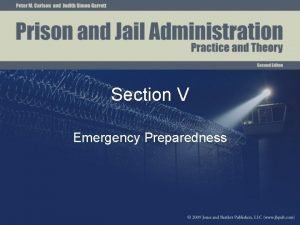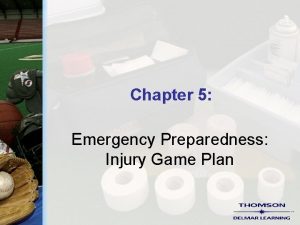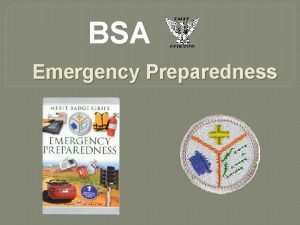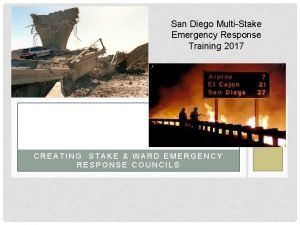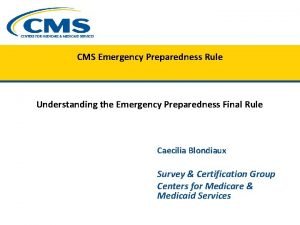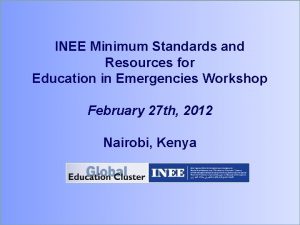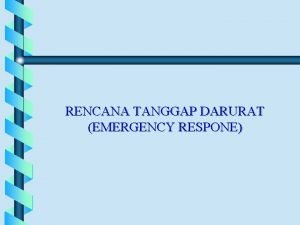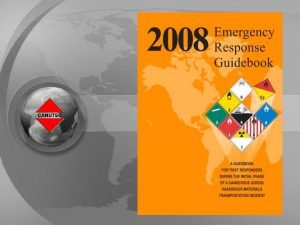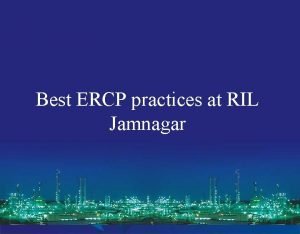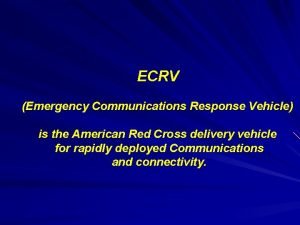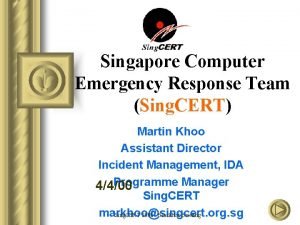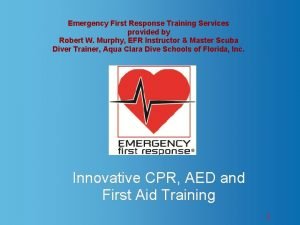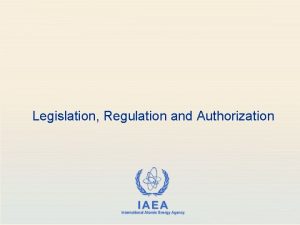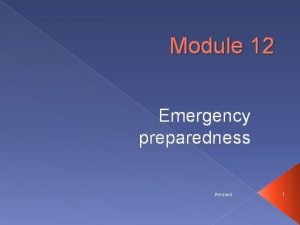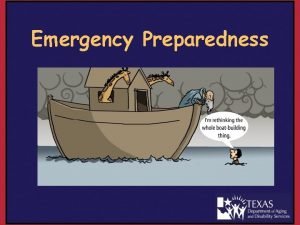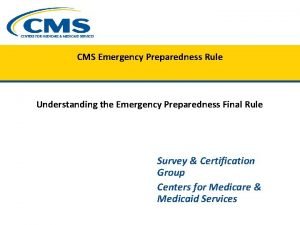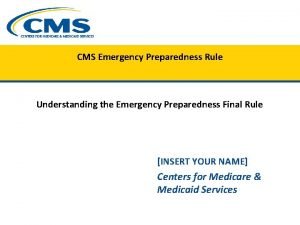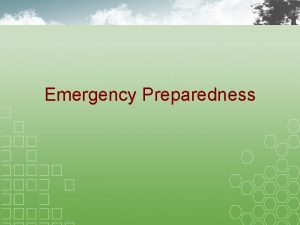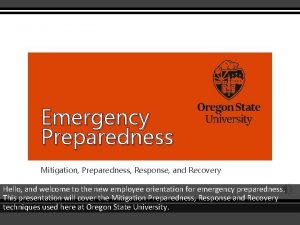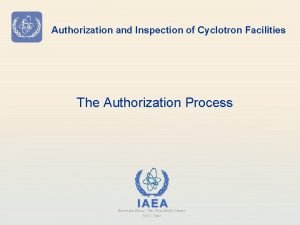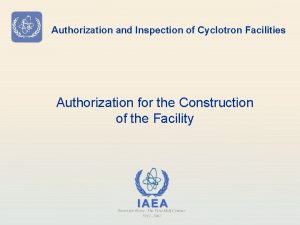Emergency Preparedness and Response Authorization and Inspection of













- Slides: 13

Emergency Preparedness and Response

Authorization and Inspection of Radiation Sources in Medical Practices Module C. 8 Objectives • To appreciate the role of emergency preparedness and response, and emergency drills. 2

Authorization and Inspection of Radiation Sources in Medical Practices Module C. 8 Contents • • • Accident Prevention - defense-in-depth Emergency preparedness Response to emergencies Investigations and follow-up Reporting and disseminating information Training and drills 3

Authorization and Inspection of Radiation Sources in Medical Practices Module C. 8 Accident Prevention - defense-in-depth “Registrants and licensees shall ensure that a multilevel (defence in depth) system of sequential, independent provisions for protection and safety commensurate with the likelihood and the magnitude of the potential exposures is applied to sources authorized. Registrants and licensees shall ensure that if one level of protection were to fail, the subsequent independent level of protection would be available…” (GSR Part 3, 3. 40) e. g. by the use of redundant and independent calibrations; external audits; in-vivo dosimetry; participation in TLD postal services, etc. 4

Authorization and Inspection of Radiation Sources in Medical Practices Emergency preparedness and response Module C. 8 “…Registrant or licensee shall prepare an emergency plan for the protection of people and the environment. As part of this emergency plan, the registrant or licensee shall include arrangements for the prompt identification of an emergency, and for determining the appropriate level of the emergency response. In relation to the arrangements for the emergency response at the scene by the registrant or licensee, the emergency plan shall include, in particular: ” a) “Provision for individual monitoring and area monitoring and arrangements for medical treatment; b) Arrangements for assessing and mitigating any consequences of an emergency” (GSR Part 3, 3. 43) 5

Authorization and Inspection of Radiation Sources in Medical Practices Module C. 8 Emergency preparedness and response (cont) “Registrants and licensees shall be responsible for the implementation of their emergency plans and shall be prepared to take any necessary action for effective response. To prevent the occurrence of conditions that could lead to a loss of control over a source or to the escalation of such conditions, registrants and licensees shall, as appropriate” : a) “Develop, maintain and implement procedures to provide the means for preventing loss of control over the source and for regaining control over the source as necessary; b) Make available equipment, instrumentation and diagnostic aids that may be needed; c) Train and periodically retrain personnel in the procedures to be followed and exercise the procedures. ” (GSR Part 3, 3. 44) 6

Authorization and Inspection of Radiation Sources in Medical Practices Module C. 8 Response to emergencies • Procedures shall be concise, unambiguous and posted where ever need is anticipated. • Responsibilities of individuals shall be identified in the emergency procedures. Actions will typically include: • rectifying the situation (e. g. stopping the irradiation; manually retract a source). • ensuring patients are removed to a safe area. • isolating the affected area. • immediately notifying the supervisor and / or RPO. 7

Authorization and Inspection of Radiation Sources in Medical Practices Module C. 8 Response to emergencies (cont) • All incidents should be reported in writing. • An accident may need investigation. • Doses can be reconstructed and should be reported for all persons involved, including the patient. • The Regulatory Body should specify the types of accidents and incidents for which a report must be submitted under the legislation. 8

Authorization and Inspection of Radiation Sources in Medical Practices Module C. 8 Investigations and follow-up “Registrants and licensees shall conduct an investigation as specified by the Regulatory Body if: (a) a quantity or operating parameter relating to protection and safety exceeds an investigation level or is outside the stipulated range of operating conditions; or (b) any equipment failure, accident, error, mishap or other unusual event or condition occurs that has the potential for causing a quantity to exceed any relevant limit or operating restriction. ” (GSR Part 3, 3. 46) 9

Authorization and Inspection of Radiation Sources in Medical Practices Module C. 8 Investigations and follow-up (cont) The licensee will: • calculate or estimate the dose(s) received and their distribution within the patient; • identify corrective measures to prevent a recurrence of the incident; • implement all corrective measures under their control; • submit a written report to the Regulatory Body as soon as possible after the investigation, or as may otherwise be specified by the Regulatory Body. 10

Authorization and Inspection of Radiation Sources in Medical Practices Module C. 8 Investigations and follow-up (cont) The licensee will: • ensure that an investigation of any reported incident is undertaken as soon as practicable; • assess the impact on staff and patient(s); • ensure that appropriate Information is provided to affected patient(s); • prepare a written report and review the investigation and recommended corrective actions with management and the responsible professionals (i. e. radiation oncologist, radiation therapist, RPO, medical physicist etc). 11

Authorization and Inspection of Radiation Sources in Medical Practices Module C. 8 Information dissemination The proper investigation and reporting of accidents and incidents, together with appropriate dissemination of the report: • provides a chance for all to learn and to avoid the same problem; • should ensure that any equipment design fault is promptly dealt with by the manufacturer and corrective action taken by other users. 12

Authorization and Inspection of Radiation Sources in Medical Practices Module C. 8 Summary • Strict observance of established (written) safety procedures would have prevented many accidents i. e. a strong safety culture is essential. • Inadequate training is a contributing factor in most accidents. • It is essential to be prepared for a radiological emergency in medical practices including emergency response training, written procedures, emergency equipment and regular drills. • All accidents and emergencies MUST be reported and investigated and, subject to regulatory requirements, reported to the Regulatory Body. 13
 Chapter 36 emergency preparedness and protective practices
Chapter 36 emergency preparedness and protective practices Chapter 36 emergency preparedness and protective practices
Chapter 36 emergency preparedness and protective practices Chapter 5 emergency preparedness injury game plan
Chapter 5 emergency preparedness injury game plan Bsa emergency preparedness
Bsa emergency preparedness National radiological emergency preparedness conference
National radiological emergency preparedness conference Stake emergency preparedness plan
Stake emergency preparedness plan Cms emergency preparedness requirements by provider type
Cms emergency preparedness requirements by provider type Preparedness mitigation response recovery
Preparedness mitigation response recovery Pengertian emergency
Pengertian emergency Erg 2008
Erg 2008 Objectives of reliance industries
Objectives of reliance industries Ecrv
Ecrv Sing cert
Sing cert The importance of training
The importance of training

